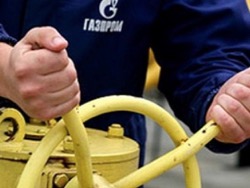
22 APR United States of America, which soon seriously expect to become the largest exporter of liquefied natural gas in the world, took the first step on this path – from the port of Louisiana for export to Europe went first tanker with LNG. This was reported with reference to its sources the journalists of the Wall Street Journal. According to preliminary calculations, 295-foot ship called the “Creole spirit” should arrive at the end point of the route, Portugal, April 27.
The American media immediately after the departure of the tanker was quick to say that the start of liquefied natural gas exports by the United States to Europe, it is likely set to shake up the European market, which has long been dominated by Russia, changing the existing balance on it. And their Portuguese colleagues even advised the Kremlin to fear of gas supplies from the US to Europe.
Russian experts, in turn, chose not to dramatize the situation, noting, however, that after 2020, when the United States work a number of projects for production of liquefied gas in the Old World, it may come to a real price war. Naturally its result may be, first, the decrease in profit of “Gazprom” and, as a consequence of Russia’s budget revenues; secondly, the loss of a monopoly share of the European market, which will also affect the amount of dividends received; and thirdly, a negative impact on the development of the Russian gas infrastructure – at least a confrontation with the United States will affect under construction and the growing power of the LNG projects, and at best put an end to plans to improve and expand the gas transportation system on the European continent.
In the “Gazprom” were quick to subdue any sudden passion. Company spokesman Sergei Kupriyanov said:

We work on contracts and not by the American press. Our prices are competitive on the European market.
Sergei Kupriyanov
However, the application to describe military terminology, a hypothetical future when referred to as “war” and the US actions – the opening of the “second gas front”, “a time bomb” and “gas attack”, do not allow to treat the event as something ordinary. Rather, they send Russia a signal, calling in the meantime, start to prepare in advance for possible consequences.
The enemy must know in person
Recently, the States is not something that didn’t claim to be a major exporter of gas, long time, domestic production could not meet the needs of the country, from which gas had to be imported. In 2014, gas imports exceeded exports by 32.3 billion cubic meters per year.
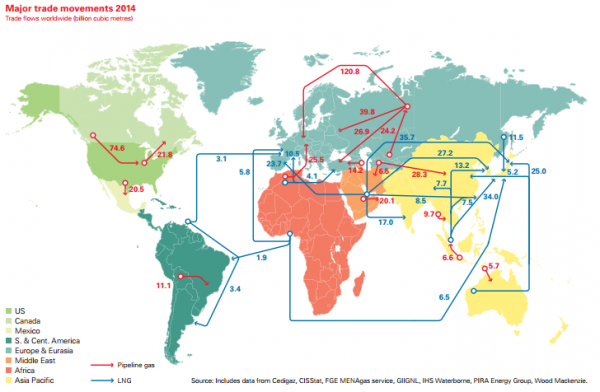 Photo: bp.com
Photo: bp.com
The door to the energy market for the United States opened the “Shale gas revolution”, which had made possible the launch of a number of LNG projects. As a consequence, in the United States were excess natural gas, which they hastened to send for export.
Politrussia.com
Immediately it should be said that the author refers to the “Shale revolution” as if it is a failure in advance and does not support all kinds of “memorial projections”. From his point of view, is to treat the slate as one of the sources of energy, which every year becomes more and more scarce. After reaching a peak production of a number of natural resources to humanity will no longer be the question of the efficiency and cost of a particular type of fuel, it will be concerned only with the problem of finding more or less a decent source of energy.
Now in the States launched only the first phase of an LNG terminal Sabine capacity of about 6 billion cubic meters (4.5 million tonnes) in the year it was harvested the first batch of gas to Europe. During 2016 it is expected to open the three phases of the terminal, the total capacity of which will grow to 24.5 billion cubic meters (18 million tons) per year.
A little later, in 2020, in the United States also plans to Commission a further four LNG terminals: CovePoint, Freeport, Cameron, CorpusCristi. According to various estimates, to 2018-2020 total capacity of the five projects can be 68-135 billion cubic meters (50-100 million tons per year, and in the long term potential of the United States is estimated at 813 billion cubic meters (600 million tons) per year.
It is impossible not to notice one strategic error made by the States initially. The US, sensing the oil and gas independence after the “Shale revolution”, were faced with a choice: to live for today or think about future generations. In other words: send the resulting surplus of gas for export or to think about how to stretch their independence from external energy supplies for as long a period. To choose the first was an obvious mistake, however, peculiar to the Americans love to live in wide leg made itself felt. In addition to the decision to begin the export resources of the United States pushed hard-hitting performance of the trade balance in recent years.
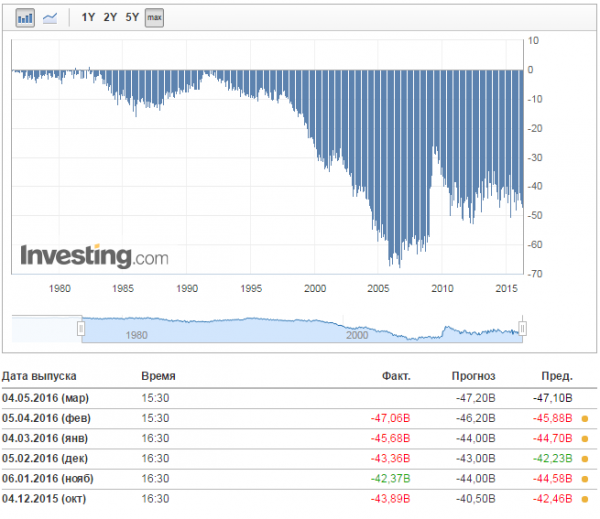 Photo: investin.com
Photo: investin.com
Of course, not all products are American manufacturers going to be for a Europe – confirmation can be considered at least that the first ever “export” the tanker departed from the United States in late February straight to Brazil. However, on the idea of the lion’s share still intended for the market of the Old world.
As usual, for this decision were not only economic reasons, such as the existence of demand for LNG and the attractive price, but also geopolitical – States even do not hide the fact that they are not opposed to “move” the position of Russia in Europe.
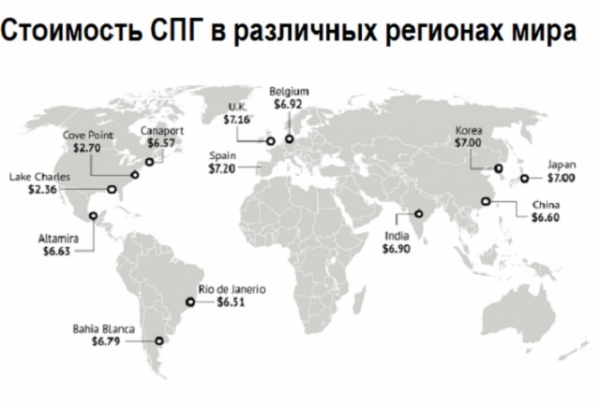 Photo: Politrussia.com
Photo: Politrussia.com
What characteristics of their product expected United States of America, in fact, starting hurriedly to the European market?
From liquefied natural gas there are a number of advantages, which include:
the <ul>
the <li>the Ability to deliver anywhere in the world where there is a regasification terminal;</li>
the <li>Ability to quickly change production volumes and gas supply, depending on market conditions;</li>
the <li>Relatively low cost: for example, according to the forecasts of the WSJ, American gas could cost at $4.3 per million BTU, while Russian — us $5.8.</li>
</ul>
At the same time in certain hands, the strengths of LNG can turn against him.
A focus on the field of battle
Perhaps the most harmless problem that may face the United States, increasing exports of LNG to Europe, is the limited capacity of the tankers.
Gas consumption in the Old World in 2015 was estimated at 510,8 billion cubic meters At the same time, the world’s largest tanker Mozah at a time is able to carry 266 thousand cubic metres – in order to cover the needs of Europe in Gaza, he would be forced to make almost two million flights.
The capacity of the whole world fleet of LNG tankers through the end of 2014 is estimated at 55.2 million cubic meters. So, all 385 of the courts, serving one Europe, would have to sail to the USA and back 9287 times.
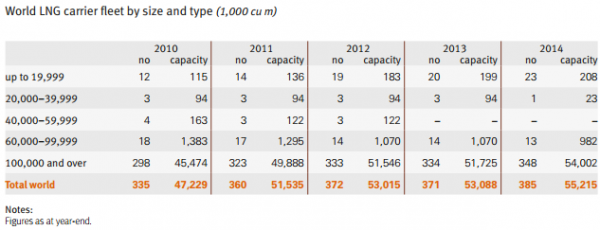 Photo: opec.com
Photo: opec.com
At the same time, the annual capacity of one only extended the “Nord stream” will be comparable to the capacity of the total tanker fleet.
But this is not the worst: the LNG market is still a somewhat smaller scale. The opportunity to obtain the coveted “blue fuel” from the tanker at a cheap price is inversely proportional to the presence of the country or its neighbors of a point regasification. And the more, the higher the cost of liquefied natural gas.
<blockquote>
The cost of us LNG is made up of several components:
1) the exchange price of the pipeline gas in the USA ($72-126 per 1 thousand cubic meters);
2) variable costs of liquefaction (15% of the cost of gas sizeimage);
3) a fixed cost of liquefaction ($81-126 per 1 thousand cubic meters);
4) the transportation of LNG by tankers (about $36 per 1 thousand cubic meters);
5) regasification ($18 per 1 thousand cubic meters).
Valuation of American LNG in Europe with different domestic gas prices in the US and under different assumptions about the attitude you have already done the costs can be expensive (up to $306 per 1 thousand cubic meters), and cheaper ($136,8 per 1 thousand cubic meters of Russian gas, whose price is estimated at $180 for 1 thousand cubic meters.
</blockquote>
Modern European infrastructure enables us to make fairly disappointing for supporters of the “American seizure” conclusion: the main consumers of Russian gas are having difficulties with the access points re-gasification, which can be considered to a certain extent even our competitive advantage.
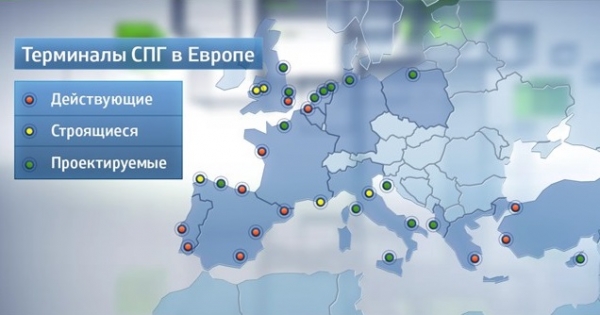 Photo: vesti.ru
Photo: vesti.ru
In the U.S. need LNG mainly the countries of Eastern Europe, which is today the locomotive of the anti-Russian hysteria. However, in their case, the situation with the presence of nearby terminals cherished the most deplorable – their next simply no.
So we get a typical picture: the whole Central and Eastern part of Europe is enmeshed in a network of pipelines without any hint of competition from LNG suppliers.
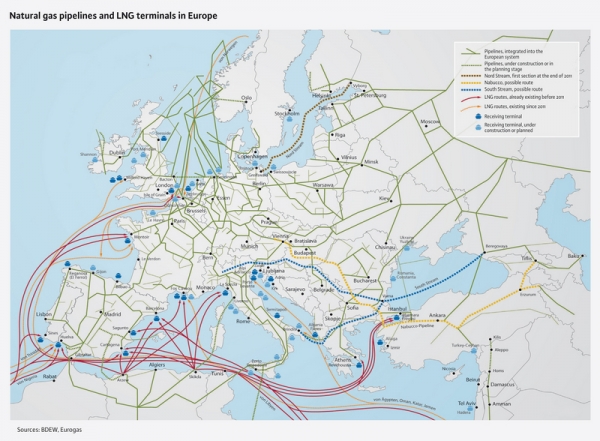 Photo: Politrussia.com
Photo: Politrussia.com
The best defense is a good offense
Russia today meets the third part of the needs of Europe in Gaza. In 2015 Gazprom supplied European countries with 158,56 billion cubic meters of gas, progressively increasing the volume of sales.
 Photo: gazprom.ru
Photo: gazprom.ru
The main consumers of Russian gas in the Old World are Germany, Italy, UK, France and Poland.
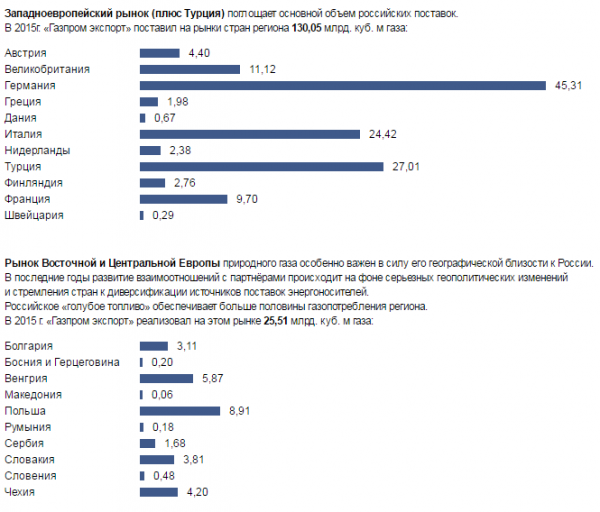 Photo: gazprom.ru
Photo: gazprom.ru
At the same time, despite their success in the market, Russia is taking steps to increase their influence. So, in 2015, an agreement was signed for the construction of the pipeline “Nord stream-2”, which clearly put US in a delicate position. Under the current price conditions of the Russian gas is clearly more attractive liquefied American, and he is clearly able to defend its market position even with the increase in oil prices.
However, all this does not make unrealistic increase in the share of LNG in the supply of energy to Europe from 10 to 20%, as previously predicted by experts. Another thing is that it will be implemented, first, not by reducing the share of Russian gas on the market, and by reducing coal consumption, and secondly, the real competition in the European market for liquefied natural gas Americans will be products of, for example, the Russian “Yamal LNG” – the construction of the project is already entering the home straight.
In contrast to the already existing LNG plant, Sakhalin-2, which is oriented mainly to the Asian market, the project of “Yamal LNG” by virtue of its location is able to attract European consumers (although, again, the main hope lays on it China). Strengths of the project include low cost of production and liquefaction of gas by saving energy density in conditions of low average annual temperatures of the Arctic.
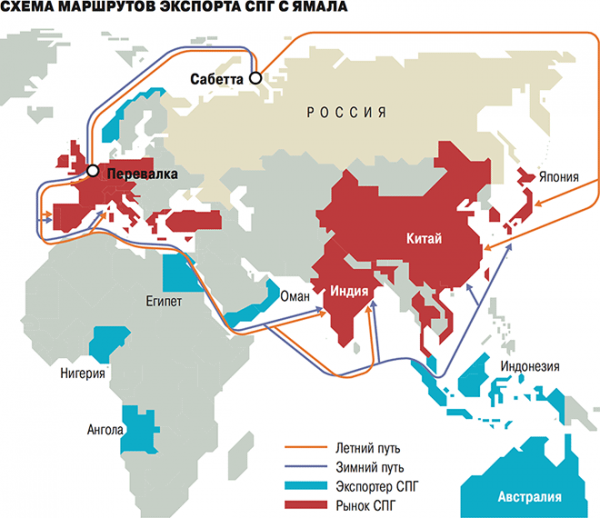 Photo: Politrussia.com
Photo: Politrussia.com
To ignore the fact that Americans feel threatened by our LNG projects, it is impossible. So, introduced after the beginning of the conflict in Ukraine, sanctions primarily hit the Russian projects of oil production and LNG production. For example, “Gazprom” pressostats the services of Gazprombank, which is included in the black list, although it was originally planned that the Bank will actively participate in the funding of the project “Baltic LNG” and “Vladivostok LNG”.
The same “Yamal LNG” for a long time had problems with financing, to solve which was only in March this year. And it is not surprising that just a month later, the US “suddenly” start your crusade on the European market.
The result to predict the today is quite difficult. If the experts are correct and the actions of the Americans by 2020 will not have a significant impact in Europe the steady-state energy balance, by the beginning of a possible “price war” Russia is already in full armor, ready and running the pipeline “Nord stream 2” and the project “Yamal LNG”. But such heavy artillery to resist will be very difficult.


